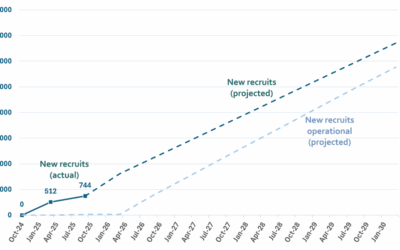- Budget provided extra £500m in tax relief for TV and film industry
- New rules create more compliance risks
- Questions around the schemes’ value for money
At TaxWatch, we’ve often written on issues which arise from the granting of generous tax reliefs to particular business sectors. Last week’s Spring Budget announced further fiscal support for the creative industries, with great fanfare and applause from industry insiders1https://www.bfi.org.uk/news/bfi-film-industry-welcome-landmark-move-increased-expenditure-credit. In this blog, we explore the implication of these changes, and raise some concerns about value for money and compliance issues.
Long-standing film tax relief (FTR) has been, since 1st January 2024, in the transitional period of being replaced by the Audio Visual Expenditure Credit (AVEC). This also replaces similar tax reliefs for high-end television, children’s television and animation. AVEC already aimed to provide slightly increased benefits compared with the original reliefs.
What changed?
In the latest Budget, the Chancellor announced a further increase in the AVEC credit rate, from 34% to 39%, for expenditure on visual effects. He also removed the 80% cap on qualifying visual effects expenditure. Both changes are intended to incentivise visual effects work to be carried out within the UK, rather than overseas. Interestingly, in the consultation2https://assets.publishing.service.gov.uk/media/6410ae9d8fa8f5560b0a60e1/M5082_Government_response_to_consultation_on_audio_visual_tax_reliefs_.pdf 2.79 onwards on AV reliefs, the government originally suggested removing the 80% cap on core expenditure, but against a lower rate of tax credit. This was to address industry concerns that the cap encouraged more portable expenditure, such as visual effects, to be moved abroad. Consultation respondents were overwhelmingly direct beneficiaries of the regime, and predictably claimed that only removing the cap without reducing the credit would lead to increased spend in the UK.
The increased benefits just announced fail to consider the potential ‘deadweight’ costs of the changes – ie. where businesses benefit from reliefs for expenditure that they would have incurred anyway. This problem plagues tax reliefs of all kinds, but is difficult to measure.
‘Indie’ film sub-scheme
The other big change to creative reliefs announced in the Budget is a new Independent Film Tax Credit (IFTC), based on the AVEC scheme with the 80% cap, but giving credit at 53% rather than 34% for films with ‘projected core expenditure of £15m’. There are slightly tighter ‘British’ criteria to be administered by the British Film Institute (BFI), but otherwise this will work like current credits. Alongside the questions around the additionality benefit of increasing reliefs, it is interesting to see that the scheme applies to films with a projected core expenditure of £15m. The detail in a policy note3https://www.gov.uk/government/publications/uk-independent-film-tax-credit/hmt-hmrc-policy-note-uk-independent-film-tax-credit indicates that qualification is based on a forecast production budget of £15m, which will be assessed by the BFI. If the final expenditure incurred exceeds £15m then the film production company (FPC) can choose whether to receive a maximum taxable credit of £6.36m (53% x 0.8 x £15m) or to claim 34% under the AVEC scheme. These kinds of boundaries should set alarm bells ringing for HMRC, as cliff edges where benefits vary cause behaviour change, and are attractive for unintended exploitation. It is not clear what criteria the BFI will use to assess whether films meet the budget criteria – how much evidence will be required to support any budget and what resources do the BFI have to scrutinise these as no additional resources have been allocated to do greater checks? There are clearly potential benefits for a film to budget for less than £15m, but then come in above that while remaining below the boundary where AVEC would match the maximum IFTC.
Compliance concerns
The changes to reliefs raise a more general issue around compliance, in relation to creative industry reliefs. As with R&D tax credits, any highly valuable reliefs will potentially attract parties that see them as ways to make money. The changes to rates available in relation to audio visual expenditure and the IFTC could both result in people attempting to reclassify expenditure, in order to get the most out of the reliefs. The high-value IFTC in particular could, at worst, attract FPCs to fraudulently inflate expenditure to recover large sums. TaxWatch has been unable to find much information about the Creative Industries Unit in HMRC who are responsible for dealing with compliance in relation to these claims. However, the NAO looked specifically at the unit’s involvement in Video Games Tax Relief (VGTR) and High-End Television (HETC) relief4https://www.nao.org.uk/wp-content/uploads/2024/01/Report-Tax-measures-to-encourage-economic-growth.pdf, and suggested they complete pre-payment manual risk assessments of individual claims which may result in compliance enquiries. It must be assumed that the unit does the same with FTR claims, although this was not specified. The details suggest that there are far more compliance issues with VGTR than HETV relief, due to a wider range of companies involved, but the compliance yield from such activity is not published and HMRC would not provide it when we requested details in relation to FTR.
TaxWatch hopes HMRC has learnt the lessons of R&D tax credits, and has considered and prepared for the compliance risks of the new more valuable reliefs.
Problems with tax reliefs
The forecast revenue foregone for all of the changes across the next five years is an estimated £500m, which also raises another issue in relation to tax reliefs as a whole. The cost of introduction of, or changes to, reliefs are estimated for a few years but, after introduction, the ongoing actual costs receive little scrutiny. This is regardless of whether or not they match the expected costs, and whether or not they produce the intended outcomes. In recent years, HMRC has contracted external parties to evaluate the benefits of FTR and HETVR. In general, the respondents were parties that had benefited from the reliefs so, unsurprisingly, the results overall indicated that the reliefs were resulting in significant additional spend in the UK5 https://www.gov.uk/government/publications/creative-industry-tax-reliefs-evaluation. However, the cost of reliefs is not evaluated against other competing priorities, nor is it subject to the same independent value for money appraisal.
Another aspect to consider is the fact that a significant proportion of total FTR cash claimed goes to the largest budget films. In 2021-22, only 3% of claims were for over £5m but in total these accounted for 69% of the total amount claimed6https://www.gov.uk/government/statistics/creative-industries-statistics-august-2023/creative-industries-statistics-commentary-august-2023#film-tax-relief. When rolling the schemes into the AVEC, the Government had the choice to limit the amount of relief that any one production could claim but chose not to – a missed opportunity in our view.
TaxWatch has previously looked at how the profits from many big budget, successful films (like those in the James Bond franchise) which benefit from large tax credits in the UK, do not actually record any of the profit in the UK, so they don’t pay corporation tax here. While clearly there’s an argument that these films create jobs and spending in the UK, it seems reasonable to ask whether there shouldn’t be a return on profit made from the UK taxpayer investment where a film is successful?
The Treasury Select Committee (TSC), Office for Tax Simplification (OTS) and National Audit Office (NAO) have all raised concerns about the lack of scrutiny of, in particular, non-structural tax reliefs, and this has led to some work on evaluating reliefs as mentioned above. Even if those evaluations suggest economic benefits of reliefs, that doesn’t necessarily mean that increasing benefits of any particular relief will proportionally increase those benefits. Noticeable in this is the range of tax incentives for film production around the world, illustrated by the Global Incentives Index, which shows how increasingly complex decisions about location must be based on tax benefits alone7https://static1.squarespace.com/static/5f7708077cf66e15c7de89ee/t/628c9f7ab7f8a17f0a11ca99/1653383041377/Global+Incentives+Index+2022-05-16.pdf. It’s regrettable that the UK has led, and continues to stoke, very significant international tax competition in a race to improve the incentives to invest. The cost to the UK Exchequer is significant and growing for the same return8https://www.irishtimes.com/business/2024/03/11/government-needs-to-consider-response-to-uk-film-tax-incentive-to-protect-irish-industry-lobby-group-warns/ . It’s hard to see how marginal tinkering with reliefs will result in increased spending in the UK, rather than just being deadweight.
One final issue with the new/enhanced reliefs, which has also been previously discussed by the TSC, NAO and OTS, is the fact that once reliefs are introduced, regardless of whether they produce the intended results, it is almost impossible to take them away. There is occasional talk of sunset clauses, where there are intentions to review them after five years, but these are argued against, due to problems of uncertainty, and are usually quietly removed. And no government wants to be the one to publicly take support away from very vocal interested parties, when losers shout much louder than winners. The moral being that a Government needs to be really sure that the reliefs are guaranteed to produce outstanding benefits to the country as a whole in all circumstances, before they’re announced. This is because they will continue to exist indefinitely, become ever more complex, more beneficial and often significantly more costly as time goes by.
Conclusion
The details above raise some of the problems with the introduction and maintenance of non-structural tax reliefs. Once in place they’re difficult to remove and often start an arms race with other countries’ tax authorities to provide the best benefits. Constant tinkering to improve them results in an industry of advisers trying to keep up with changes, and costs often increase significantly without any real evaluation of the economic benefits. TaxWatch would like to see government stand back from the ongoing focus on the details of such reliefs, and properly evaluate the value for money they provide – as would happen with other government spending.
References



